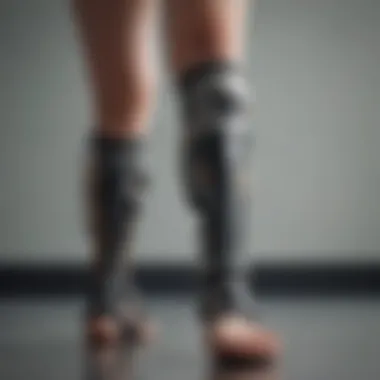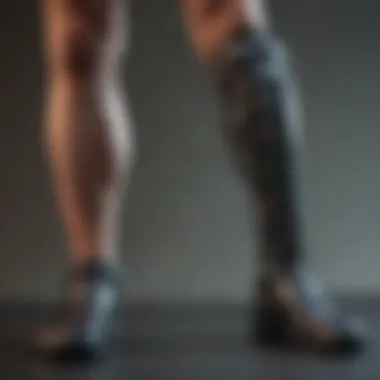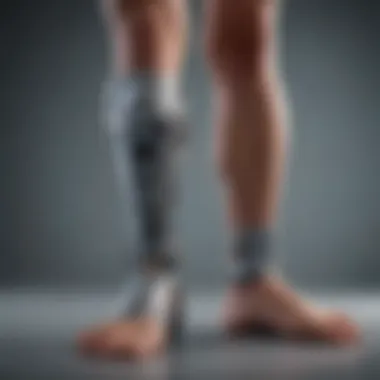Exploring Bionic Prosthetic Legs: A Detailed Insight


Intro
The evolution of prosthetics has undergone a significant transformation in recent years with the advent of bionic technology. This article aims to explore the advancements in bionic prosthetic legs, shedding light on their development, technology, and implications for users. As we delve into this innovative field, it becomes evident that these devices are not just mechanical replacements, but rather sophisticated systems designed to enhance the mobility and quality of life for individuals with limb loss.
Research Overview
Summary of Key Findings
Bionic prosthetic legs represent a paradigm shift in rehabilitation technologies. Several studies reveal that these devices integrate advanced sensors, motors, and artificial intelligence to provide a more natural walking experience. Key findings indicate the following:
- Improved user mobility and independence compared to traditional prosthetics.
- Enhanced user satisfaction due to personalized fitting and adaptive functionalities.
- A significant reduction in the energy expenditure required for walking, making it easier for users to engage in physical activities.
The empirical data supporting these findings underscores the potential for bionic limbs to transform the rehabilitation landscape, making them an area of increasing interest in both academic and clinical settings.
Relevance to Current Scientific Discussions
Scientific discourse surrounding bionic prosthetics often intersects with broader themes in biomechanics, robotics, and user-centered design. The research contributes to discussions about how technology can bridge the gap between capability and experience for individuals with disabilities. Current debates also focus on the ethical considerations of advancing technologies, including accessibility and affordability for those in need.
Methodology
Research Design and Approach
To gain a comprehensive understanding of bionic prosthetic legs, both qualitative and quantitative research methods were utilized. A combination of user surveys, clinical trials, and case studies provides a robust framework for analysis. This mixed methods approach allows for a deeper interpretation of user experiences and outcomes associated with bionic leg usage.
Data Collection and Analysis Techniques
Data collection involved:
- Surveys: Targeting users of bionic limbs to gather information on their mobility, satisfaction, and challenges.
- Clinical Trials: Assessing the impact of various designs and technologies in real-world settings.
- Interviews: Conducting sessions with professionals in orthotics and biomechanics to understand current trends and innovations.
Data analysis was performed using statistical tools and qualitative coding techniques to identify themes and correlations within the data. This approach ensures a comprehensive evaluation of the findings, paving the way for further advancements in the technology.
A bionic prosthetic leg can significantly improve an amputee's lifestyle, allowing them a level of mobility previously thought unattainable.
As we proceed with this exploration, it is crucial to consider the intricate interplay between technology and human experience. Understanding the design and functionality of bionic prosthetic legs can help illuminate the future of rehabilitation and mobility solutions.
Preamble to Bionic Prosthetics
Bionic prosthetics have revolutionized the field of rehabilitation, combining advanced engineering and biomedical science. Their significance lies in their ability to restore mobility to individuals who have lost limbs due to injury or medical conditions. As technology evolves, the design and functionalities of bionic legs improve, catering to user needs and enhancing their quality of life. This section will explore the basic concepts and the historical context that led to this remarkable technological advancement.
Definition of Bionic Prosthetic Legs
Bionic prosthetic legs are artificial limbs that utilize electronic and mechanical components to replicate the functionality of a biological leg. Unlike traditional prosthetics, which may only provide basic support, bionic legs often incorporate sensors, motors, and advanced control systems. These systems enable the user to experience more natural movements, mimicking the gait of an able-bodied person. The integration of technology allows for a range of motions and responses to environmental factors, making them suitable for various activities, from walking to running.
Historical Development of Prosthetics
The development of prosthetics dates back thousands of years. Early prosthetic devices were simple and often rudimentary, constructed from materials such as wood or leather. For instance, the ancient Egyptians crafted wooden toes for individuals with amputated toes. As time progressed, prosthetics became more sophisticated, reflecting advancements in materials and design philosophy.
In the 20th century, significant milestones were achieved. The introduction of lighter materials such as carbon fiber and the advent of more complex mechanical systems led to improvements in functionality. Furthermore, the exploration of electromechanical and hydraulic systems paved the way for modern bionics.
The introduction of bionic technology in the late 20th century marked a turning point. With the advent of microprocessors and sensory feedback, bionic legs began to simulate the natural biomechanics of human movement. These innovations have not only increased mobility but also provided users with a more intuitive experience.
In summary, bionic prosthetic legs represent a significant leap in prosthetic technology. The journey from rudimentary wooden devices to advanced electronic systems underscores human ingenuity and the drive for mobility. As we delve into further sections, we will examine technological advancements, design features, and the profound impact these innovations have on users' quality of life.


Technological Advancements
Technological advancements play a pivotal role in the evolution of bionic prosthetic legs. These innovations significantly enhance the functionality and user experience of prosthetics, bridging the gap between human movement and mechanical assistance. Through continuous improvements, bionic legs are becoming more adaptive, intuitive, and efficient, fundamentally altering the lives of users.
Materials Used in Bionic Legs
The materials selected for bionic prosthetic legs directly influence their performance and comfort. Traditional prosthetics often employed heavy metals and plastics, which resulted in cumbersome devices that offered limited mobility. In contrast, modern bionic legs utilize advanced materials such as carbon fiber, titanium, and thermoplastics. These materials are lightweight yet remarkably strong, allowing for greater agility and ease of movement.
- Carbon Fiber: Known for its high strength-to-weight ratio, carbon fiber provides excellent durability while minimizing weight.
- Titanium: This metal is known for its lightweight nature and resistance to corrosion, making it a popular choice for structural components.
- Thermoplastics: These materials are not only flexible but also moldable, allowing for a more tailored fit to the user's limb.
By utilizing these advanced materials, designers can create prosthetics that not only support physical activity but also enhance the quality of life for users by reducing fatigue associated with heavy devices.
Microprocessors and Sensors
Microprocessors and sensors are core components of bionic prosthetic legs, elevating their functionality beyond basic mechanical movement. These devices enable real-time data processing, allowing the prosthetic to respond to the user’s movements and the environment.
- Sensors: Equipped with various sensors, bionic legs can detect changes in terrain, slope, and load, adjusting movement accordingly.
- Microprocessors: These act as the brain of the prosthetic, processing input from sensors and controlling motors to facilitate smooth and natural motions. They ensure that the bionic leg mimics the user’s intent, contributing to a more seamless experience.
This integration of smart technology transforms bionic legs into sophisticated devices capable of enhancing mobility and improving user confidence.
Power Sources and Battery Life
The power source is another fundamental aspect of bionic leg technology. As advanced functionalities increase, so does the demand for reliable power. Traditional battery systems often fell short in providing lasting energy for everyday use, limiting the effectiveness of prosthetics.
- Lithium-Ion Batteries: Commonly used due to their high energy-to-weight ratio, these batteries can power complex systems while being comparatively lightweight.
- Rechargeable Systems: Many modern bionic legs incorporate rechargeable batteries, offering convenience and sustainability. Users are no longer confined to short periods of use but can enjoy extended periods of mobility.
The development of better power sources directly affects the user experience, ensuring that these individuals can engage in daily activities without concern for their device's battery life.
Functional Design Features
The importance of functional design features in bionic prosthetic legs cannot be overstated. These features significantly influence the effectiveness, usability, and overall experience of users. Understanding how these systems function and how they integrate with human biomechanics can lead to better outcomes for those who rely on them. This section discusses the critical elements that define functional design in bionic limbs, including the distinctions between mechanical and bionic systems, user control mechanisms, and the customization process.
Mechanical vs. Bionic Systems
Mechanical prosthetic legs have been the traditional choice for amputees. They rely on simple pivot points and springs to enable basic walking functions. However, they often fall short in mimicking natural movements. Bionic systems, on the other hand, integrate advanced technology to enhance mobility. These include microprocessor-controlled components that react dynamically to the user's movement and terrain changes.
"Bionic limbs represent a paradigm shift from the purely mechanical approach, offering a more natural walking experience."
This shift allows users to engage in various activities that would be difficult with a mechanical leg. For instance, going uphill or navigating uneven surfaces becomes manageable with a bionic leg. Additionally, the improved stability provided by bionic systems further reduces the risk of falling.
User Interface and Control Mechanisms
Bionic prosthetic legs come equipped with user interfaces that allow for personalized settings and adjustments. These systems often utilize sensors to capture the wearer’s movement intentions. For example, pressure sensors in the foot provide feedback on whether the user is standing still or in motion.
Control mechanisms can vary between models. Some prosthetics offer intuitive control through muscle signals, known as myoelectric control. Others might allow adjustments through mobile applications, giving users flexibility in their daily life. This combination of technology creates a more user-centered experience, fostering independence.
- Key User Features:
- Intuitive control
- Sensor feedback
- Mobile application support
Customization and Fitting Process
An integral part of optimizing functional design in bionic prosthetics is the customization and fitting process. Every individual has unique needs based on their lifestyle, preferences, and anatomy. Therefore, customizing a bionic leg involves thorough assessments, including gait analysis and discussions about daily activities.
Fitment can also require periodic adjustments as the user adapts. This adaptive process ensures that users can maximize their mobility while feeling comfortable and secure. Moreover, ongoing care and maintenance are necessary to extend the lifespan of the device and prevent complications.


In summary, functional design features in bionic prosthetics play a crucial role in enhancing the user experience. By blending advanced technology with personalized adjustments, these systems promise to revolutionize mobility for amputees.
Impact on Quality of Life
The concept of quality of life is pivotal in the discussion of bionic prosthetic legs. As technology advances, these devices not only restore mobility but also significantly influence the daily experiences of users. Understanding the impact on quality of life involves exploring the multidimensional benefits that bionic limbs provide. They go beyond mere functionality; they facilitate physical rehabilitation, address psychological factors, and foster social integration. Each of these elements plays a crucial role in enhancing both well-being and the overall experience of users.
Physical Rehabilitation
Physical rehabilitation is often the first step for individuals who have lost a limb. Bionic prosthetic legs are designed to aid in this process. They offer a range of controlled movements that help users regain strength and balance. Patients typically undergo physiotherapy to adapt to their new limb, which may involve specific exercises tailored to the capabilities of their bionic leg.
These devices can mimic natural movement patterns, making it easier for users to relearn how to walk. The goal of rehabilitation is not only to restore mobility but also to build confidence in the use of the prosthetic. Positive outcomes from physical rehab can lead to enhanced muscle tone, improved flexibility, and greater independence. Moreover, successful rehabilitation can contribute to long-term physical health benefits, potentially reducing the risk of chronic conditions associated with inactivity.
Psychological Effects of Bionic Limbs
The psychological effects of using a bionic limb are complex. For many users, bionic prosthetics symbolize a return to normalcy. They can help to alleviate feelings of loss or identity issues stemming from limb loss. However, the transition to using bionic limbs can also introduce challenges. Users may experience frustration during the adjustment period due to the learning curve associated with operating advanced technology.
Support systems, including counseling and peer networks, are essential in addressing these psychological effects. Many individuals report improved self-esteem, greater social engagement, and even emotional relief when they transition to bionic limbs. This transformation acknowledges the power of technology in not just physical rehabilitation, but also in psychological recovery and resilience.
Social Implications and Integration
Social integration is a critical aspect of quality of life for users of bionic legs. Advanced prosthetics can significantly enhance mobility, allowing users to participate in social activities that were previously challenging or impossible. The accessibility of various environments, physical events, and social gatherings is greatly improved when individuals can move freely.
However, social implications also include the need for societal acceptance and awareness. Traditional perceptions surrounding disabilities and prosthetics can sometimes hinder social interactions. Education and advocacy are vital in shaping a more inclusive society that recognizes the capabilities of individuals with bionic limbs. By fostering understanding, communities can better support integration efforts, ultimately enhancing the quality of life for those who rely on bionic technology.
"Bionic legs represent not only a technological advancement but also a pathway to reclaiming life and identity."
In summary, the impact of bionic prosthetic legs on the quality of life is profound. From physical rehabilitation to psychological healing and social integration, each aspect contributes to a more fulfilling life for users. As technology evolves, it will likely continue to shape these experiences, making the need for diligent exploration and understanding more critical than ever.
Ethical Considerations
The integration of bionic prosthetic technology raises significant ethical issues that merit thorough examination. As advancements continue to reshape the landscape of prosthetic limbs, understanding the ethical implications becomes crucial. These considerations influence not only accessibility and safety but also the trajectory of human augmentation. In this section, we delve into the ethical dimensions of bionic legs by focusing on access and equity, safety standards, and the future of human augmentation.
Access and Equity in Prosthetic Technology
Access to bionic prosthetic legs is not uniform. Variations in geographic location, socioeconomic status, and healthcare systems determine who gets access to these advanced technologies. There is a pressing need to establish equity in prosthetic technology to ensure that individuals from all backgrounds can benefit from these innovations.
Key points include:
- Socioeconomic Barriers: The high costs of cutting-edge prosthetics often place them out of reach for low-income individuals. This disparity raises ethical concerns about fairness and justice.
- Geographic Disparities: In rural or less developed areas, access to specialized clinics that provide fitting and care for bionic limbs can be limited.
- Insurance Coverage: Policies on what prosthetics are covered often lag behind technological advancements, leaving patients to bear significant out-of-pocket costs.
Each of these factors contributes to a system where not everyone has the same opportunities for mobility and quality of life.
Safety and Regulatory Standards
Bionic prosthetic legs must meet rigorous safety and regulatory standards. Ensuring safety involves evaluating both materials used and the technology integrated into these devices. Ethical responsibilities demand that producers adhere to strict regulations to protect users.
Important elements include:
- Regulatory Bodies: Organizations like the FDA play a critical role. They review bionic device safety before they reach consumers, which is vital in establishing trust among users.
- User Testing: Comprehensive trials must be conducted to ascertain the durability and safety of bionic limbs. These evaluations affect long-term health and usability.
- Innovation vs. Safety: Balancing rapid technological advancements with established safety protocols poses an ethical dilemma for manufacturers.
Maintaining high safety standards is not just a regulatory necessity; it is an ethical obligation to protect the users' well-being.
Future of Human Augmentation


As technology advances, the notion of human augmentation evolves. There are profound ethical implications tied to enhancing human capabilities through bionic prosthetics. The future holds possibilities that may expand the limits of human abilities but also raises questions about identity and societal norms.
Factors worthy of consideration include:
- Redefining Ability: What does it mean to be disabled in a world where artificial enhancements can restore or even surpass natural ability?
- Potential for Inequality: Enhanced individuals may gain advantages in several areas, potentially leading to a new form of inequality. This situation would challenge the ethical frameworks that govern our society.
- Public Perceptions: How society views augmented individuals will influence acceptance and integration. Creating an ethical stance on augmentations must consider public perception and hope for a balanced perspective.
The conversation on bionic prosthetics and human augmentation is ongoing. It reflects societal values and challenges the moral compass of our time.
In summation, ethical considerations in the realm of bionic prosthetic legs highlight the need for equitable access, stringent safety standards, and an examination of our societal values surrounding enhancement. These discussions are critical as we navigate the complexities of integrating technology with human life.
Future Directions in Bionic Leg Technology
The development of bionic prosthetic legs is profoundly shaped by ongoing research, technological advancements, and user feedback. Future directions in this field promise enhancements that not only improve functionality and comfort but also integrate seamlessly with the user's physiological and psychological needs. With an emphasis on innovation, the focus broadens to include the emerging technologies, potential for neural integration, and collaborative global research efforts. This section will explore these dimensions, illustrating their significance for users and the field of rehabilitation as a whole.
Emerging Innovations
Innovative technologies are set to redefine the capabilities of bionic legs. Current advancements focus on improving mobility, responsiveness, and overall user experience. For instance, the incorporation of lightweight materials such as carbon fiber and advanced polymers enables the production of prosthetic legs that are not only durable but also lightweight. This helps to enhance mobility without adding excessive weight.
Another key innovation involves smart sensors and microprocessors that adapt to various terrains. These systems can analyze real-time data to adjust their performance according to the user's movement. The ability to detect changes in surface, slope, or even the user's gait allows for dynamic adjustments, creating a more natural walking experience.
"The integration of smart technology into bionic legs is paving the way for a new era of mobility, reflecting a significant shift in prosthetic design philosophy."
Moreover, the exploration of 3D printing technology is revolutionizing customization. As a result, the manufacturing process can yield tailored solutions for individual users, improving fit and comfort while reducing wait times for prosthetic replacements or adjustments.
Potential for Neural Integration
Neural integration represents a frontier with significant potential to enhance the interaction between bionic legs and their users. The concept revolves around creating a communication link between the brain and the prosthetic limb. This could allow users to control their bionic legs with thoughts, much like natural limbs.
Recent advancements in neuroprosthetics have shown promise in enabling movement through brain-machine interfaces. By interpreting neural signals, these interfaces can control the artificial limb's functions. This technology not only restores movement but also encourages a more intuitive use of the prosthesis.
Upcoming research seeks to enhance this connection further through advancements in bioengineering and neuroscience. By successfully bridging the gap between digital and biological systems, users can expect to experience a more natural control of their prosthetic limbs, improving overall functionality and user satisfaction.
Global Research Initiatives
Global collaboration in research initiatives is crucial for the advancement of bionic leg technology. Major universities and research institutions worldwide are engaged in projects aimed at improving prosthetic designs and functionalities. Collaborative efforts often include interdisciplinary teams of engineers, doctors, and user advocates.
For instance, projects like the European Union Horizon 2020 program are investing millions in research focused on advanced prosthetics. These initiatives are exploring various aspects, from material science to user-centered design.
In addition, platforms like Reddit and Facebook serve as avenues for sharing developments and experiences between researchers and users. These interactions foster community input that drives the innovation process. By encouraging feedback directly from users, developers can better understand the challenges faced, leading to more targeted solutions.
Through concerted efforts in research and development, the future holds the potential for bionic legs that are not only more functional but also aligned with user experiences, creating an inclusive environment for all.
Finale
The conclusion serves as a synthesis of the key themes discussed throughout the article. It emphasizes the transformative nature of bionic prosthetic legs and the profound benefits they offer to users. Not only do these advanced devices restore mobility, but they also enhance independence and improve overall quality of life for amputees. The integration of cutting-edge technology, such as sensors and microprocessors, allows these prosthetics to adapt to various terrains, emulating natural movement.
Throughout the article, the importance of accessibility to these technologies is highlighted. Ethical considerations play a critical role in ensuring that all potential users have equitable access to bionic limbs irrespective of socioeconomic status. As advancements continue, the focus on user-centered design must remain paramount to address individual needs.
In summary, the development of bionic prosthetic legs illustrates the intersection of technology, rehabilitation, and ethics. As we continue to explore this dynamic field, it becomes crucial to consider not just the technical specifications, but also the human experience and how these innovations redefine the lives of users.
Summary of Key Insights
- Technological Integration: Bionic prosthetic legs are equipped with sophisticated technology that mimics natural limb function. Innovations such as microprocessors and adaptive sensors play an essential role in user experience.
- Impact on Users: The psychological and social implications of using bionic limbs cannot be understated. Many users report increased confidence and a heightened sense of belonging in social settings.
- Ethical Responsibility: As the technology progresses, there must be an emphasis on ethical standards and ensuring fair access for all those in need.
The Path Ahead for Bionic Limb Users
Looking forward, the future of bionic limb technology holds immense potential for further enhancing the user experience. Ongoing research aims at seamless integration with the nervous system, potentially providing even greater cognitive and physical control.
Moreover, collaborative efforts among researchers, healthcare providers, and policymakers are essential to drive innovations in accessibility. The path ahead promises a collective commitment to improving the quality of life for individuals with limb loss.
By fostering an environment of inclusivity and technological advancement, we can expect to see bionic limbs not just as tools, but as extensions of the human body that empower users in their daily lives.



